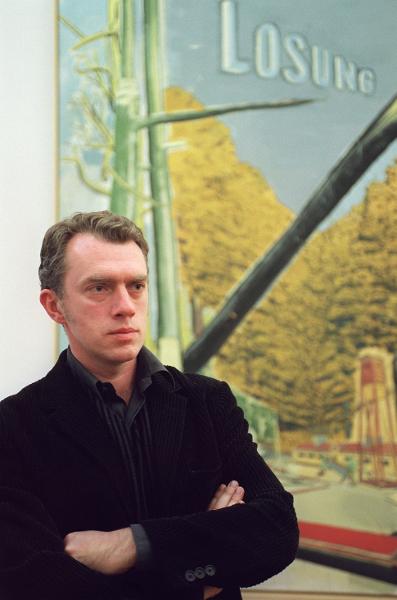Source

Source: picture-alliance / ZB (c) ZB – Fotoreport
In the 1990s, the painter Neo Rauch became the poster child of the so-called New Leipzig School, a group of young artists who trained at the venerable Academy of Visual Arts in Leipzig [Leipziger Hochschule für Grafik und Buchkunst]. Through skillful marketing on the part of certain Leipzig gallery owners, the members of this group achieved both worldwide acclaim and commercial success. From the outset, the label “Leipzig School” was more of a marketing strategy (or brand) than a name for an art movement – not least because group members have differing styles and reject the label in most cases. In terms of common characteristics, however, all are highly skilled technicians who share a devotion to figurative art. In this respect, they are part of an East German tradition – whereas abstract painting took hold of West Germany in the postwar period, figurative painting never lost its grip in the GDR. And within that larger East German tradition, their work exhibits certain qualities for which Leipzig is specifically known: historical consciousness, compositional rigor, meticulous craftsmanship, and an attention to perspective, space, and the placement of figures. Generally speaking, the artists of the "New Leipzig School" favor muted palettes and melancholy subject matter; they also share a general interest in architectural motifs and interior scenes.
The photo below was taken at the opening of a Neo Rauch exhibition at the Gallery of Contemporary Art in Leipzig in 2000. It shows Rauch (born 1960) in front of one of his paintings. Rauch’s monumental canvasses owe a clear debt to Socialist Realism but also reflect other influences, namely Pop Art and Surrealism. His paintings have been exhibited widely, both in Germany and abroad: in 2007, he was given a solo exhibition at the Metropolitan Museum of Art in New York.
Other members of the all-male "New Leipzig School" include: Tilo Baumgärtel, Christoph Ruckhärberle, Martin Kobe, Matthias Weischer, all of whom were born in the early 1970s. Despite, or perhaps even because of, their great commercial success, the artists of the "New Leipzig School" are not without their critics, many of whom regard their work as prosaic, contrived, and depressing, and view their success largely as the result of hype.

Source: picture-alliance / ZB (c) ZB – Fotoreport